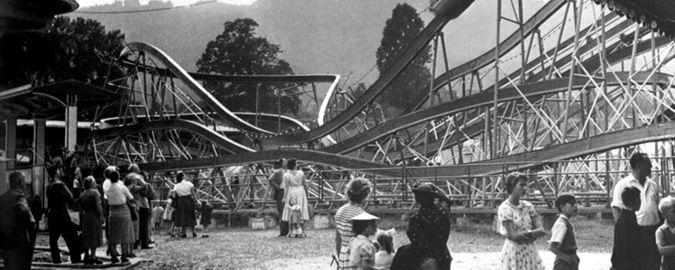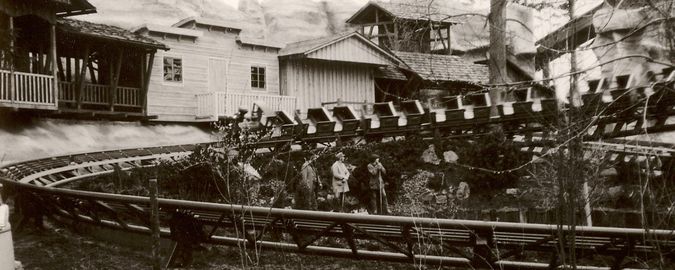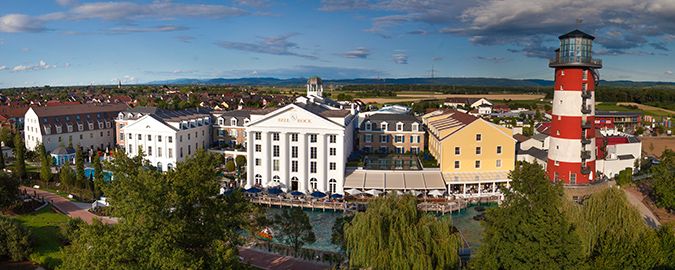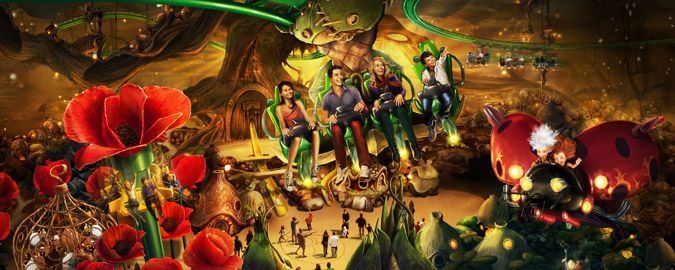The Europa-Park Resort has a company history to be extremely proud of: 250,000 visitors came when it opened in the summer of 1975, and today, the family-run park is the most popular tourist destination in the country. With more than six million visitors in 2022, Europa-Park is by far the biggest theme park in Germany – and the most visited seasonal park in the world. With more than 100 attractions and international shows, fun and entertainment for the whole family is guaranteed on a site measuring 95 hectares. The water world Rulantica is also open to all visitors every day. Guests can expect fantastic water fun in spacious indoor and outdoor areas. But Europa-Park is much more than a traditional theme park: it is now a well-known location for conferences and popular venue for events and television productions. Thanks to Germany's largest connected hotel resort with a wide range of food options, it is also a unique short break destination for visitors from all over the world.
Almost 50 years of the Europa-Park Resort
A success story brought to you by the Mack Family
From vision to reality: Europa-Park is born
Franz Mack and his son Roland came up with the idea of opening their own theme park with entertainment for all ages during a tour of the USA in 1972. At the same time, they wanted it to be an exhibition space for products manufactured in Waldkirch by Mack Rides, so that potential customers could see how the amusement rides worked in practice. It took three years to implement the project, and Europa-Park opened its doors for the first time in 1975. Once the family was back in Germany, the first task was to find a suitable site. At that time German parks had a primarily regional focus, but the Macks’ vision was much broader from the start. The current location in Rust was not the site under consideration at the beginning. There was a piece of land by a small artificial lake called ‘Europa-See’ in Breisach, a town dating back over 4,000 years and located right on the Franco-German border, which initially seemed perfect for the plans.
Despite advanced preparations and numerous permits having been put in place, the project fell through because of an objection from the Federal Waterways and Shipping Administration, which had its own plans for the land. The one thing that does, however, remain from Breisach – the town that back in 1950 was the first European town to implement a pilot poll (initiated by ‘Europa-Union Deutschland’) on the formation of a European federal state and has since really bought into the European concept – is the name of the park: Europa-Park.
The subsequent search for a new site then threw up a piece of land directly on the motorway between Karlsruhe and Basel, near Neuenburg. Plans got underway immediately, only to once again be thwarted by an authority: the Stuttgart motorway administration demanded the widening of a motorway underpass, which would have cost considerable time and money.
Nevertheless, anyone thinking that the project would be stopped because of the difficulties finding a location was quickly corrected by the project’s bosses. Eventually they became aware of a centuries-old castle gardens on a piece of land in Rust – also not far from the Karlsruhe/Basel motorway – which was owned by the local authority. The fishing village of Rust, which at the time had fewer than 3,000 inhabitants, supported the theme park project from the start. The village’s mayor – the meanwhile deceased Erich Spoth and freeman of the park – was particularly active in his support for the planners and made the park and castle on the banks of the ‘Alte Elz’ available to them. An adjacent fairy tale park was also purchased, taking the total area up to 16 hectares. After drawn-out negotiations with authorities and administrations, it was finally time to begin construction. Europa-Park opened its doors for the first time in 1975.
1975-1985: The early years, growth despite initial opposition
The development of Europa-Park is a textbook success story. The workshops of Waldkirch were already famous in the eighteenth century for their skills in carriage building. In 1870, the company took another step and began to make circus wagons and carrousels. By 1915 the company Mack Rides was already ‘purveyor to the court’ of Circus Krone; in 1921 it created the first rollercoaster. From 1930 onwards the family business specialised in circus trucks, carrousels, ghost trains and rollercoasters. In 1951 the company Mack built the first bobsleigh run out of wood; only a year later, the company took the plunge into business in the United States of America. Under the leadership of Franz Mack, the company went global. The foundations of this successful rise were innovative concepts for rides and entrance into the theme park business. The latter happened in 1975 with the founding of Europa-Park in Rust, partially a sort of ‘display window’ for the in-house products. Under the leadership of Franz Mack and his sons, Roland and (later) Jürgen, there was an optimal combination of parks, entertainment, culture and the thrill of fun rides – almost all of them constructed by the parent company Mack Rides in Waldkirch.
But not everyone believed in the success story right away: there was a lot of scepticism in the beginning. Headlines such as ‘The vultures are hovering over Rust’ and ‘What’ll happen to the ruins of the theme park in Baden’s fishing village?’ were some of the initial, not-exactly-euphoric reactions of the press to the Macks’ idea to build a theme park in Rust. But the visitor numbers proved them wrong: 250,000 visitors came in 1975, as many as 700,000 descended a year later, and the million mark was met for the first time in 1978. One key step was the opening of the Italian-themed area in 1982, and the implementation of the European theme concept in collaboration with stage designer and film architect, Ulrich Damrau.
1985-1996: European orientation, market leader, first awards
The European theme concept was pursued systematically, with careful attention to detail: Holland, England, France, Scandinavia, Spain and the German Alley were added in 1984, 1988, 1990, 1992, 1994 and 1996 respectively. The concept proved to be visionary, particularly in view of the political reorganization of Europe going on at that time. Signed in 1985, the Schengen Agreement opened up the borders between the member states over the next ten years.
The Mack brothers' great ambition to achieve high quality began to pay off. Whether in the catering, rides, gardens or shows, the priority was always utmost quality. Europa-Park was the only German theme park to be graded as ‘very good’ by consumer organization Stiftung Warentest in 1990. Two million people visited the park in 1991.
In 1996 Stiftung Warentest came to a clear conclusion: ‘Overall, Europa-Park in Rust has the broadest and most high-quality offering at a reasonable price – particularly compared with Disneyland Paris.’ Tourism expert Prof. Dr. Horst W. Opaschowski from Hamburg went a step further, immortalizing himself with the following entry in Europa-Park's guest book: ‘Experience your life – that's the prognosis for the future. Here in Rust, the future has long since begun.’
1995-2016: Development into a short break destination
A new era began in 1995 with the opening of ‘El Andaluz’, the first hotel in a German theme park. Longer stays – resulting from the park having more and more to offer – led to an increase in the pressure on accommodation. The 4* hotel was booked up at a rate of 87 per cent in the first year. The ‘Castillo Alcazar’, another 4* hotel, was then built in 1999. Demand was enormous: total hotel occupancy in the year 2000 was 97.7 per cent. A new record was achieved in the park: three million visitors.
In 2001/2002 Europa-Park became the first theme park in Germany to open its doors for a winter season. 180,000 visitors came during the six weeks that it was open. With the site’s prominence as a tourist magnet growing, the park opened its own motorway exit in spring 2002, after decades of wrestling with the issue.
In 2002 MackMedia was founded as part of the Mack International Group. With this company, Managing Director Michael Mack aimed to create new entertainment experiences and make their presence even stronger outside of the park. MackMedia was created to take the world of Europa-Park into a digital future.
It was only a matter of time before a third 4* themed hotel was built. The Italian/Roman-style ‘Colosseo’, opened in 2004, was the largest individual hotel in southern Baden, boasting 1,450 beds. Open all year round, the 4* Superior hotel ‘Colosseo’ managed to chalk up a dream occupancy rate of 95 per cent in the first year. This was followed by the 4* Superior themed hotel, ‘Santa Isabel’, built in the style of a Portuguese monastery, in 2007. The fifth themed hotel, ‘Bell Rock’, was opened in 2012. In this latest 4* Superior hotel, designed in the New England style, visitors can follow in the footsteps of the Pilgrim Fathers and explorers who once ventured to new shores and crossed the Atlantic on an adventurous voyage to the New World. Together with ‘El Andaluz’, ‘Castillo Alcazar’, ‘Colosseo’ and ‘Santa Isabel’, the ‘Bell Rock’ became part of the biggest hotel resort in Germany, adding a further 1,000 beds to the wide range of accommodation available. Thanks to the increased hotel capacity, the number of two-day visitors began to rise continually, and the zone of influence began to expand. This has led to many overnight stays being booked at both the Europa-Park hotels and other hotels in the tourist region of the Black Forest.
In 2005 Franz Mack was delighted to receive a very special award: the senior boss of the Mack corporate group was accepted into the ‘Hall of Fame’ in Atlanta as one of the ‘pioneers of the international success of amusement parks.’ He was awarded the accolade at the world’s largest trade fair for amusement parks in Atlanta, by President of the IAAPA (International Association of Amusement Parks and Attractions), Clark Robinson.
Corporate business also grew with the increased range of event and meeting rooms on offer. More than 1,300 events a year are now handled by Confertainment, founded in 1998. Alongside this, Europa-Park began to gain significance as a media location: today it is a popular set for national and international film and TV productions. Around 200 TV shows are recorded at the park each year.
2009 – 2019: Expansion, Roland Mack becomes president of the international association, ‘Ammolite – The Lighthouse Restaurant’ becomes the only starred restaurant in a theme park, sixth hotel ‘Krønasår'
In 2009 Europa-Park was expanded by 15 hectares. The new Iceland themed area, with the gigantic ‘blue fire Megacoaster’, covered an area of two hectares. Iceland expanded the European countries concept further and featured Europe’s highest loop on a catapult coaster. In 2012 the area of Europa-Park was expanded once again, this time by five hectares: the fifth themed hotel, ‘Bell Rock’, complete with modern fitness club, and the spectacular wooden rollercoaster ‘WODAN – Timburcoaster’ were built. In erecting the first wooden rollercoaster, Europa-Park was following in the footsteps of its parent firm, Mack Rides in Waldkirch, which had been manufacturing rides of this type since 1921. Just under 100 years later ‘WODAN – Timburcoaster’ was integrated into the park. With a length of 1,050 metres, height of 40 metres, speed of over 100 kilometres an hour and maximum vertical acceleration of up to 3.5 G, it guarantees a fast ride full of myths and legends, and plenty of adrenaline!
At the end of November 2011 Europa-Park was accorded a great honour: Roland Mack was the first German to be appointed President of the IAAPA. Together with his colleagues on the board, he dedicated himself first and foremost to the strategic development of the sector, international exchange of experiences and further harmonisation of safety standards.
Another highlight: the fine dining restaurant ‘Ammolite – The Lighthouse Restaurant’ integrated into the 4* Superior hotel ‘Bell Rock’ was awarded two Michelin stars and 16 Gault&Millau points in 2014, just two years after it was opened. In March 2020, head chef Peter Hagen-Wiest and his team succeeded in this once again. In November 2018, the influential gastronomy guide Gault&Millau again awarded the fine dining restaurant 17 out of 20 possible points. This makes Europa-Park the first theme park in the world to have a starred restaurant!
Since the 2014 season Europa-Park has also been spiriting its visitors away into a mini-world of superlatives: at the family attraction ‘ARTHUR – In the Minimoys Kingdom’, nature becomes a great adventure. The gigantic realisation of the lovingly detailed scenery from the star director Luc Besson's successful film trilogy ‘Arthur and the Invisibles’ shows off the secret world of the small characters.
Europa-Park turned 40 in 2015 and celebrated its jubilee year with numerous new features and surprises. One of these was the new Express Lane. This ensures that visitors start enjoying the numerous attractions even sooner: the conveyor from the car park to the main entrance provides hassle-free transportation of guests to Europa-Park. A further highlight was the redesign of the Euro-Tower in the French themed area. With the help of MackMedia, the ‘Alpenexpress Coastiality’ – a world first – was unveiled in September 2015. Passengers in the Austrian themed section can enjoy an adventure never experienced before using virtual reality glasses.
With the opening of the new Ireland – Children's World themed area, the 2016 season was all about family. Old and young guests can discover the most beautiful side of the Emerald Isle through a lovingly detailed presentation of the strong Irish tradition. In July Roland Mack received the German Founders' Prize for his life's work – one of the highest honours for entrepreneurs in Germany. The IAAPA also honoured the founder and owner of Europa-Park by granting him the highest distinction that the world association of the theme park industry can grant: in November 2016, Roland Mack was incorporated to the IAAPA Hall of Fame, joining the ranks of industry giants like Walt Disney.
Since spring 2017, the ‘Europa-Park Arena’ has been completed and is available next to the ‘Europa-Park Dome’ for major events. With an area of around 3,000 square metres, the multifunctional hall allows for events with unexpected dimensions. Up to 5,000 guests can experience magical moments here. With the ‘Voletarium’, in June the world’s best theme park also features a new major attraction. The largest ‘Flying Theatre’ in Europe takes its passengers to the most beautiful and fascinating places on the continent. In two theatres, up to 140 explorers glide spectacularly through the gigantic space with chairlift-like flying machines. In addition, MackMedia presents ‘Happy Family’, the first feature-length production. Starting in August, the film brings the adventures of the Wünschmann family to cinemas first nationwide, and later around the worldwide in more than 60 other countries.
In 2018, Germany's largest theme park is dedicated to its beloved neighbour France: After extensive modernisation, visitors to Europa-Park can look forward to a redesigned French themed area. With a fresh look as well as new attractions and dining options, the Grande Nation is the season’s highlight. In the centre there is the beloved silver sphere, housing a world first: inside there is both classic rollercoaster fun in the dark and an exciting ride with the Eurosat - CanCan Coaster or an innovative virtual reality experience and a futuristic trip with Eurosat Coastiality.
In 2019, the Scandinavian themed area opened, including new gastronomy and shopping options. Since 31st May 2019, the new hotel ‘Krønasår’ has welcomed its first visitors. The sixth themed hotel in Europa-Park is an essential part of the expansion of the resort. The 4* superior hotel is a special type of natural history museum, offering stylish accommodation with a Nordic ambience for up to 1,300 overnight guests.
2019 – 2024: Opening of the water world Rulantica, ‘Restaurant of the Future’ and new multi-launch coaster ‘Voltron Nevera powered by Rimac’
After a construction period of 26 months, the new Europa-Park water world opened on 28th November 2019. Adventurers of all ages can explore ten themed areas and 27 unique attractions across 32,600 square metres, including two saunas for visitors aged 18 and over, and 25 sparkling water attractions for the whole family. The unique mix of Scandinavian landscapes, mystical sceneries and imaginative designs are inspiring.
Not a year after the opening, visitors in October 2020 had a new highlight to look forward to. With ‘Hyggedal’, an exclusive, 1000-square-metre wellness and sauna area was created. The largest expansion to date is the Nordic outdoor slide world ‘Svalgurok’, which opened on 3rd June 2021. Ten slides, embedded amongst breathtaking scenery, guarantee some watery fun for the whole family.
After a long wait, the ‘Pirates in Batavia’ and the ‘Bamboe Baai’ restaurant returned to the Dutch themed area on 28th July 2020, after a construction period of only 24 months. For more than 30 years, the lovingly-designed family attraction, with its many details, was a magnet for visitors at Europa-Park - until a fire destroyed it in May 2018. The attraction had created unforgettable memories for many, as well as a great desire to breathe life back into the ‘Pirates in Batavia’ as soon as possible.
As the world's first VR experience of its kind, MackNeXT and VR Coaster presented YULLBE in 2020. The ‘Full Body Tracking Free Roaming VR Experience’ allows guests to move freely while perceiving themselves and up to seven other players completely within a virtual space. A year later, YULLBE. received the coveted Brass Ring Award in the ‘Best New Product: Virtual Reality’ category. Another magical new world came with VEEJOY, this time bringing the magic of Germany's largest theme park and the Rulantica water world home. The new streaming platform combines a wide variety of media content on a single page.
On 4th November 2022, the owners, the Mack family, opened the ‘Restaurant of the Future’. Eatrenalin is a futuristic gastronomic event concept situated next to the 4* superior hotel ‘Krønasår’, having received a lot of international attention. As soon as the experience begins, visitors are immersed in different worlds, made possible by the impressive interplay of multimedia content, top-class gastronomy and a patented new development called the Floating Chair from Mack Rides. Guests are spoiled with an eight-course menu.
In the 2022 season, Germany's largest theme park also exceeded a threshold of 6 million visitors for the first time in its almost 50-year history, representing a significant expansion of its market leadership.
Since 8th February 2023, the new ‘Nordiskturn’ area in Rulantica offers visitors the chance for some real competition with the ‘Vikingløp’ racing slide. The 30-metre-high tower features eight tube slides, which visitors slide down head-first on mats. Over 400 loungers and seats in the 'Nordiskturn' ensure plenty of relaxation after the spectacle.
Since 23rd March 2023, guests have been able to experience an interactive 3D action thriller in the new YULLBE PRO Experience ‘Amber Blake: Operation Dragonfly’. The 30-minute Virtual Reality Experience is based on the ‘Amber Blake’ comic series from Belgian supermodel Jade Lagardère and features thrilling state-of-the-art technology and a nerve-wracking adventure across Singapore’s skyline.
In 2024, Europa-Park continues with its intensive construction work. More than 700 craftsmen work on over 40 construction projects during the off-season. This includes the internationally renowned Stryker coaster ‘Voltron Nevera powered by Rimac’ being built in the new Croatia themed area. Along a track of 1385 metres, the 14th rollercoaster offers seven inversions, 2.2 seconds of weightlessness in one go, and holds a world record with the steepest launch of 105°.
Two traditional classics, the ‘Alpenexpress Enzian’ and the ‘Tyrol Log Flume’, will also be returning to the Austria themed area in 2024, with new splendour. The rides, which were destroyed by fire in 2023, were rebuilt in a very short time alongside the ‘Magic Valley of Diamonds’.
During the season, 5,000 employees - including 150 trainees and students from the Baden-Württemberg Cooperative State University - ensure smooth processes both in front of and behind the scenes in Europa-Park; each employee receives qualified training and further education at our own Europa-Park Academy. Alongside this, Germany's largest theme park also secures up to 10,000 indirect jobs. This makes the owner-managed company one of the largest employers in the region and one of the strongest economic drivers in South Baden.
Future and change of generations
The owner family Mack have a lot planned for the coming years: alongside optimisation of existing facilities, the focus primarily lies on continual growth and creation of new attractions and themed areas, as well as an extension of the Rulantica water world. With the construction of a new rollercoaster in the future, Europa-Park will again offer a very special highlight.
The next Mack generation is therefore assuming great responsibility: since 2016, Michael and Thomas Mack have been part of the Europa-Park Executive Board together with their father Roland Mack and their uncle Jürgen Mack. As Managing Directors, they oversee various business areas.
The amusement industry of tomorrow, developed and implemented by Mack today – a concept that also applies to the future. Satisfied visitors are one of the most important factors for success. As such, Europa-Park continues to focus consistently on quality and innovation. ‘Our visitors deserve nothing but the best, and that's exactly what they get from us’, says Roland Mack, owner of Europa-Park. The successful Baden entrepreneur received the ‘Buzz Price Award' for his life's work and his outstanding entrepreneurial achievements as well as his great commitment to the industry.
A comparison in figures
| 1975 | 2024 | |
|---|---|---|
| Area in hectares | 16 | 95 |
| Employees | 50 | 5.000 |
| Beds | 0 | 5.800 |
| Caravan pitches | 0 | 200 |
| Gastronomic outlets | 5 | Over 90 |
| Ticket prices | 5.00 DM | up to €69.50 |
| Attractions | 15 | over 100 |
| Shows | 1 puppet show | 23 hours of shows per day |
Further information is also available at europapark.de and at rulantica.de
During the 2024 summer season, Europa-Park will be open daily from 9am to 6pm (longer opening times in the main season). Day specific tickets are available at tickets.europapark.de or in conjunction with an overnight stay europapark.de/reservierung. Information at: 07822 / 77 66 88. Further information at europapark.de.
Rulantica is open daily from 10am to 10pm (for guests of the Europa-Park hotels with a valid entry ticket, the park opens daily at 9am) Due to the limited capacity, we recommend booking Rulantica Tickets in advance online. Tickets are available at tickets.rulantica.de or in conjunction with an overnight stay at europa-park.de/reservierung Information at: 07822/77 66 55. Current information and admission prices can be found at rulantica.de






